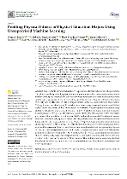Profiling Physical Fitness of Physical Education Majors using Unsupervised Machine Learning

Author
BONILLA, D
SÁNCHEZ-ROJAS, I
MENDOZA-ROMERO, D
Publication date
2022Published in
International Journal of Environmental Research and Public HealthVolume / Issue
1 (146)ISBN / ISSN
ISSN: 1661-7827ISBN / ISSN
eISSN: 1660-4601Metadata
Show full item recordCollections
This publication has a published version with DOI 10.3390/ijerph20010146
Abstract
The academic curriculum has shown to promote sedentary behavior in college students. This study aimed to profile the physical fitness of physical education majors using unsupervised machine learning and to identify the differences between sexes, academic years, socioeconomic strata, and the generated profiles. A total of 542 healthy and physically active students (445 males, 97 females; 19.8 [2.2] years; 66.0 [10.3] kg; 169.5 [7.8] cm) participated in this cross-sectional study. Their indirect VO2max (Cooper and Shuttle-Run 20 m tests), lower-limb power (horizontal jump), sprint (30 m), agility (shuttle run), and flexibility (sit-and-reach) were assessed. The participants were profiled using clustering algorithms after setting the optimal number of clusters through an internal validation using R packages. Non-parametric tests were used to identify the differences (p < 0.05). The higher percentage of the population were freshmen (51.4%) and middle-income (64.0%) students. Seniors and juniors showed a better physical fitness than first-year students. No significant differences were found between their socioeconomic strata (p > 0.05). Two profiles were identified using hierarchical clustering (Cluster 1 = 318 vs. Cluster 2 = 224). The matching analysis revealed that physical fitness explained the variation in the data, with Cluster 2 as a sex-independent and more physically fit group. All variables differed significantly between the sexes (except the body mass index [p = 0.218]) and the generated profiles (except stature [p = 0.559] and flexibility [p = 0.115]). A multidimensional analysis showed that the body mass, cardiorespiratory fitness, and agility contributed the most to the data variation so that they can be used as profiling variables. This profiling method accurately identified the relevant variables to reinforce exercise recommendations in a low physical performance and overweight majors.
Keywords
cardiorespiratory fitness, physical endurance, muscle power, sprint speed, range of motion, unsupervised machine learning
Permanent link
https://hdl.handle.net/20.500.14178/2452License
Full text of this result is licensed under: Creative Commons Uveďte původ 4.0 International




